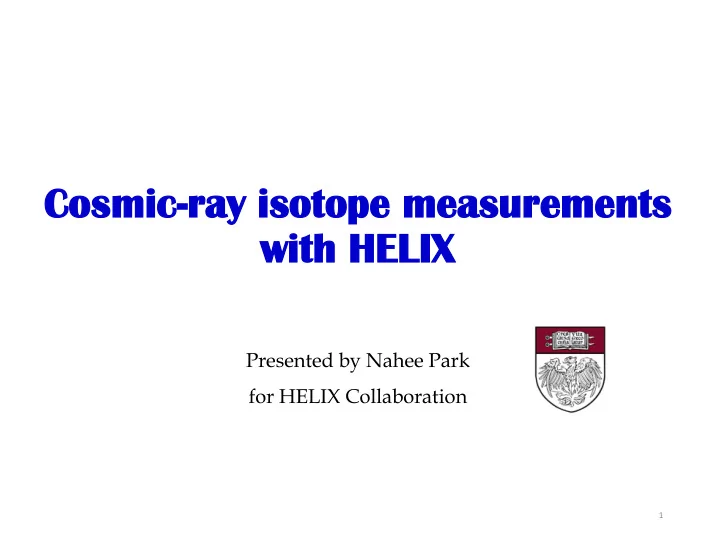

Co Cosm smic ic-ray ray iso sotope tope mea easurement surements s wi with th HEL ELIX IX Presented by Nahee Park for HELIX Collaboration 1
Understanding the cosmic-ray propagation is essential to study the origin and acceleration of the cosmic rays Cosmic Ray sources Earth 3
Understanding the cosmic-ray propagation is essential to study the origin and acceleration of the cosmic rays Cosmic Ray sources CR nuclei CR electron Earth 4
Understanding the cosmic-ray propagation is essential to study the origin and acceleration of the cosmic rays Cosmic Ray sources Breaks in the light elemental spectra Rising positron fraction Difference in H & He indexes The importance of propagation studies of CR nuclei the cosmic rays has become more vital CR electron Earth 5
Elemental Secondary-to-Primary ratio Best measured observable to study the propagation : Secondary-to-primary ratio (e.g. B/C) Sensitive to the amount of matter traversed by the CRs → Degeneracy between average amount of matter traversed and average life time 6
Propagation clock isotope, 10 Be 10 Be : Unstable isotope w/ known half life of 1.5 × 10 6 yr 10 Be/ 9 Be ratio provides strong constraints for the propagation models Challenging measurements o Several good measurements at a few hundred MeV/nuc o Above this, the ISOMAX balloon payload covers up to ~2 GeV/nuc Good model discriminating power around 3 GeV/nuc I. Moskalenko - “AMS02 Days” 7
Propagation clock isotope, 10 Be 10 Be : Unstable isotope w/ known half life of 1.5 × 10 6 yr 10 Be/ 9 Be ratio provides strong constraints for the propagation models Challenging measurements o Several good measurements at a few hundred MeV/nuc o Above this, the ISOMAX balloon payload covers up to ~2 GeV/nuc Good model discriminating power around 3 GeV/nuc I. Moskalenko - “AMS02 Days” 8
High Energy Light Isotope eXperiment University of Chicago Scott Wakely , Dietrich Müller, Nahee Park, Ian Wisher Indiana University James Musser, Mark Gebhard, Brandon Kunkler, Mike Lang, Gerard Visser Pennsylvania State University Stéphane Coutu, Isaac Mognet Northern Kentucky University Scott Nutter University of Michigan Michael Schubnell, Gregory Tarlé, Andrew Tomasch, Noah Green Ohio State University Jim Beatty McGill University David Hanna 9
HELIX A new magnet spectrometer payload to measure 10 Be/ 9 Be isotope ratio up to 10 GeV/n Two stage approach to cover wider range of energy Stage 1 : designed to have a flight in Antarctica with a long duration balloon in 2019 10
HELIX A new magnet spectrometer payload to measure 10 Be/ 9 Be isotope ratio up to 10 GeV/n Two stage approach to cover wider range of energy Stage 1 : designed to have a flight in Antarctica with a long duration balloon in 2019 Very challenging measurements o Mass resolution of few % up to 10 GeV/n o Readout within a very strong magnetic field ( HEAT superconducting magnet, B field at the center ~ 1 T ) • All SiPM readout → Needs good thermal design o Total ~ 26k channels for full configuration 11
HELIX Configuration TOF 1.5cm thickness scintillator, readout by SiPMs, 2.3m separation Timing resolution < 50 psec for Z=4 Magnet 1T superconducting magnet, reused from HEAT experiment Drift Chamber Tracker Low material tracker to minimize scattering Spatial resolution ~65 um for Z>3 RICH 1 m 2 focal plane covered by SiPM arrays Δ β / β ~1 ✕ 10 -3 for Z>3, up to 3 GeV/n (stage 1) 12
HELIX Configuration TOF 1.5cm thickness scintillator, readout by SiPMs, 2.3m separation Timing resolution < 50 psec for Z=4 Magnet 1T superconducting magnet, reused from HEAT experiment Drift Chamber Tracker Low material tracker to minimize scattering Spatial resolution ~65 um for Z>3 RICH 1 m 2 focal plane covered by SiPM arrays Δβ/β ~1 ✕ 10 -3 for Z>3, up to 3 GeV/n (stage 1) Detail on I. Wisher’s talk 13
Expected performance HELIX stage1 performance goals 7-14 day exposure w/ 0.1 m 2 sr geometry factor 10 Be/ 9 Be ratio up to ~3 GeV/n with Δm /m ~2.5% o Measure the charge of CR up to neon (Z=10) o Mass resolution of few percentage for light isotopes up to 3 GeV/n 14
Expected performance HELIX stage1 performance goals 7-14 day exposure w/ 0.1 m 2 sr geometry factor 10 Be/ 9 Be ratio up to ~3 GeV/n with Δm /m ~2.5% Future Upgrade for stage 2 Energies up to 10 GeV/n w/ upgrades to spectrometer & RICH 15
HELIX – current status Moving forward to be ready for a flight in 2019! Finalize the detector configuration Proto-type testing and initial production Stage 1 full instrument integration in 2018 16
Summary Recent high-precision cosmic-ray measurements have highlighted the importance of well-constrained propagation models Precision isotopic measurements, in particular the 10 Be/ 9 Be ratio, provide key inputs for these models HELIX, the High Energy Light Isotope eXperiment, is a new LDB magnet spectrometer payload designed to make these measurements HELIX is moving forward to prepare for a flight in 2019 17
Recommend
More recommend